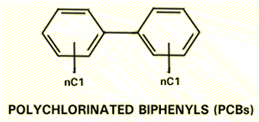 PCB
Contamination of Food
PCB
Contamination of Food  PCB
Contamination of Food
PCB
Contamination of Food

PCBs encompass a class of chlorinated compounds that includes up to 209 variations, or congeners, with different physical and chemical characteristics [1]. PCB mixtures are colorless to dark brown oils, viscous liquids, or sticky resinous semi-solids [2].
Chronic exposure of animals to PCBs can lead to disrupted hormone balances, reproductive failures, or cancer. Food can be a major source of human PCB exposure, usually from fish and animal fat. PCBs are lipophilic; they preferentially separate from water and adsorb to sediment at the bottoms of lakes and rivers. Bottom feeders and other aquatic organisms then ingest and accumulate PCBs, resulting in bioconcentration upward in the food chain. Composite analysis of commercial whole fish collected from Lake Ontario in 1980 found PCB levels of 0.11 to 4.90 parts per million (ppm) [2].
The toxicity of PCBs was dramatically illustrated in 1968 when over 1600 people in Japan were poisoned by cooking oil contaminated with PCBs from a heat transfer unit. The contaminating oil likely contained furans and dioxins, compounds generally more toxic than PCBs themselves. The ensuing illnesses became known as "Yusho" (rice oil disease)[2].
PCBs can be released into the general environment from poorly maintained toxic waste sites; by illegal or improper dumping of PCB wastes, such as transformer fluids; through leaks or fugitive emissions from electrical transformers containing PCBs; and by disposal of PCB-containing consumer products in municipal landfills [2]. PCBs have been found in at least 271 of 1177 hazardous waste sites on the EPA National Priorities List [2]. Of the 1.25 billion pounds of PCBs produced in this country since 1929, about 450 million pounds have found their way into the environment [2]. The chemical stability of these synthetic compounds accounts for their persistence in the environment. Another important reason for their persistence is their resistance to biodegradation. Low levels of PCBs can be found throughout the world. PCBs in water or on soil surfaces evaporate and return to earth by rainfall or settling of dust particles. Because PCBs strongly adsorb to soil particles, significant leaching from soil and translocation to plants do not occur [2]. Although PCBs are widespread in the aquatic environment, their low water solubility helps to prevent high concentrations in drinking water supplies [2].
Today PCBs are found mainly in transformers and capacitors manufactured before the U.S. Environmental Protection Agency (EPA) banned the production of PCBs in 1977, and although PCBs are no longer manufactured in the United States, the greatest potential for exposure to PCBs still occurs in the workplace [2]. However, nonoccupational exposures have also occurred and are of more concern to the general public. The public has encountered PCBs through illegal roadside dumping of hazardous waste oils and through inhalation of smoke and soot from transformer or capacitor fires [2]. When PCBs are burned, they can produce dioxins and furans, placing smoke-inhalation victims at increased risk of exposure to these toxic compounds. Fetuses and neonates are potentially more sensitive to PCBs than adults because their livers are less developed and unable to metabolize and excrete the PCBs. Furthermore, PCBs accumulate in breast milk, so nursing infants are at additional risk. Other populations potentially more sensitive to PCBs are persons with compromised liver functioning, including alcoholics or those with congenital disorders such as Gilbert's syndrome, and persons with liver infections, such as hepatitis B. Persons taking medications potentially toxic to the liver may also be at increased risk [2].
The federal government has taken the following steps:
The EPA has set a maximum contaminant level of 0.0005 milligrams PCBs per liter of drinking water (0.0005 mg/L). The EPA requires that spills or accidental releases into the environment of 1 pound or more of PCBs be reported to the EPA [3].
The Food and Drug Administration (FDA) requires that milk, eggs, other dairy products, poultry fat, fish, shellfish, and infant foods contain not more that 0.2–3 parts of PCBs per million parts (0.2–3 ppm) of food [3].
Here are some very informative external links that pertain to PCBs in food:
References
1. About PCBs (Polychlorinated Biphenyls), EPA document number EPA/540/s-93/506, URL: http://mcni.net/~copa/gen/pcbov.htm
2. ATSDR Case Studies in Environmental Medicine, Polychlorinated Biphenyl (PCB) Toxicity, Issue 12, June 1990. URL: http://mcni.net/~copa/med/pcbatsdr.htm
3.ATSDR Polychlorinated Biphenyls (PCBs), CAS# 1336-36-3, September 1997 URL: http://atsdr1.atsdr.cdc.gov:8080/tfacts17.html
This Page prepared by B.T. Johnson, December 1997 UCD EXTOXNET FAQ Team.